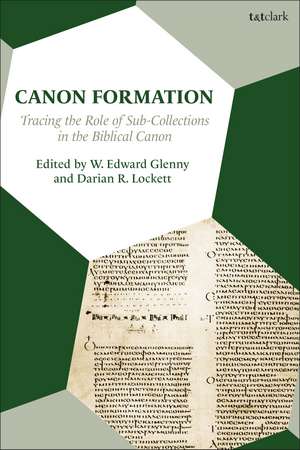Canon Formation: Tracing the Role of Sub-Collections in the Biblical Canon
Editat de Professor W. Edward Glenny, Associate Professor Darian Locketten Limba Engleză Paperback – 21 aug 2024
| Toate formatele și edițiile | Preț | Express |
|---|---|---|
| Paperback (1) | 194.87 lei 3-5 săpt. | |
| Bloomsbury Publishing – 21 aug 2024 | 194.87 lei 3-5 săpt. | |
| Hardback (1) | 659.99 lei 6-8 săpt. | |
| Bloomsbury Publishing – 8 feb 2023 | 659.99 lei 6-8 săpt. |
Preț: 194.87 lei
Preț vechi: 251.25 lei
-22% Nou
Puncte Express: 292
Preț estimativ în valută:
37.29€ • 39.87$ • 31.09£
37.29€ • 39.87$ • 31.09£
Carte disponibilă
Livrare economică 27 martie-10 aprilie
Preluare comenzi: 021 569.72.76
Specificații
ISBN-13: 9780567709172
ISBN-10: 0567709175
Pagini: 368
Dimensiuni: 156 x 234 x 25 mm
Greutate: 0.52 kg
Editura: Bloomsbury Publishing
Colecția T&T Clark
Locul publicării:London, United Kingdom
ISBN-10: 0567709175
Pagini: 368
Dimensiuni: 156 x 234 x 25 mm
Greutate: 0.52 kg
Editura: Bloomsbury Publishing
Colecția T&T Clark
Locul publicării:London, United Kingdom
Caracteristici
No other text introduces the reader to the specific state of the question for each of the major canonical sub-collections
Notă biografică
Darian R. Lockett is Associate Professor of New Testament at Talbot School of Theology, Biola University, USA.W. Edward Glenny is Professor of New Testament Studies and Greek at University of Northwestern St. Paul, USA.
Cuprins
List of ContributorsForwardLee Martin McDonald IntroductionW. Edward Glenny and Darian R. Lockett Section One: The Bible as a Whole and the Old and New Testament as Canonical UnitsThe Bible Canon and Its SignificanceTomas Bokedal The Canonical Shape of the Hebrew Old TestamentStephen G. Dempster The Canonical Shape of the Greek Old TestamentJohn Meade The Canonical Shape of the New TestamentMatthew Y. Emerson Section Two: Old Testament Canonical Sub-UnitsThe Pentateuch as CanonStephen B. Chapman The Canon of PsalmsNancy L. deClaissé-Walford The Canonical Role of Israel's Wisdom CollectionCraig G. Bartholomew The Macro-Structure of the MegillothTimothy Stone The Canonical Function of the Nebi'imChristopher Seitz Prophetic Intentionality in the TwelveDon C. Collett The Book of the Twelve in the SeptuagintW. Edward Glenny Section Three: New Testament Canonical Sub-Units The Fourfold Gospel CollectionGregory R. Lanier Corpus ApostolicumDarian R. Lockett The Pauline CorpusE. Randolph Richards Revelation as the End of the CanonKu¨lli Tõniste Section Four: Hermeneutical Considerations of Canon Hermeneutical Reflections on Canonical Sub-Collections: Retrospect and ProspectChed SpellmanBibliographyIndex
Recenzii
The focus on sub-units of the biblical books in this volume is a most welcome focus that has not received adequate attention by earlier scholars or in my work on canon formation. This volume provides an important advance on canon formation in this often neglected area.
For years now, the scholarly interest in the biblical canon has only seemed to grow. But lacking in many of these discussions has been a deep exploration of the form and structure of the canon, with special attention to canonical sub-units. This new volume gathers together an impressive group of scholars who provide well-researched and even-handed essays that fill this important gap. I highly recommend it.
For years now, the scholarly interest in the biblical canon has only seemed to grow. But lacking in many of these discussions has been a deep exploration of the form and structure of the canon, with special attention to canonical sub-units. This new volume gathers together an impressive group of scholars who provide well-researched and even-handed essays that fill this important gap. I highly recommend it.
